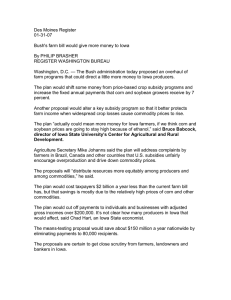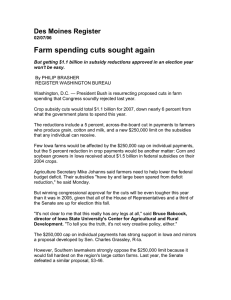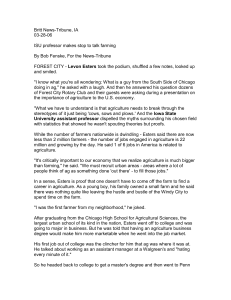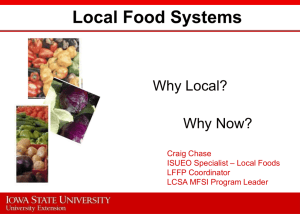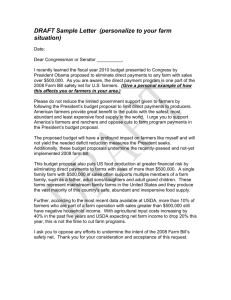Des Moines Register 02-01-07 Iowans could gain under farm proposals
advertisement
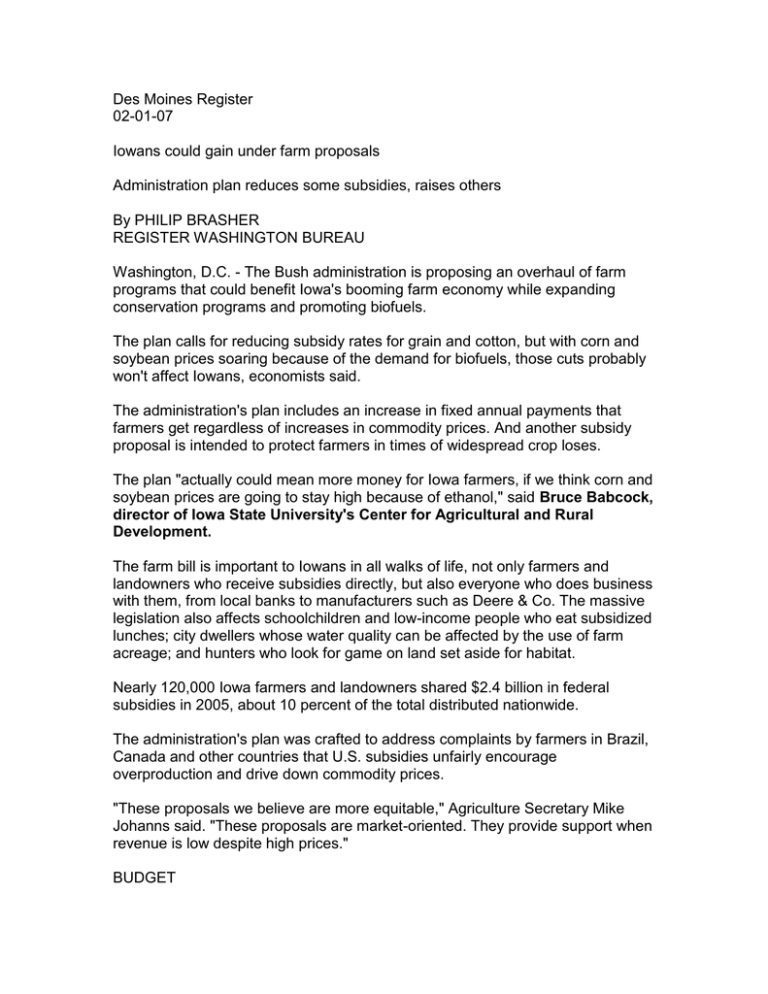
Des Moines Register 02-01-07 Iowans could gain under farm proposals Administration plan reduces some subsidies, raises others By PHILIP BRASHER REGISTER WASHINGTON BUREAU Washington, D.C. - The Bush administration is proposing an overhaul of farm programs that could benefit Iowa's booming farm economy while expanding conservation programs and promoting biofuels. The plan calls for reducing subsidy rates for grain and cotton, but with corn and soybean prices soaring because of the demand for biofuels, those cuts probably won't affect Iowans, economists said. The administration's plan includes an increase in fixed annual payments that farmers get regardless of increases in commodity prices. And another subsidy proposal is intended to protect farmers in times of widespread crop loses. The plan "actually could mean more money for Iowa farmers, if we think corn and soybean prices are going to stay high because of ethanol," said Bruce Babcock, director of Iowa State University's Center for Agricultural and Rural Development. The farm bill is important to Iowans in all walks of life, not only farmers and landowners who receive subsidies directly, but also everyone who does business with them, from local banks to manufacturers such as Deere & Co. The massive legislation also affects schoolchildren and low-income people who eat subsidized lunches; city dwellers whose water quality can be affected by the use of farm acreage; and hunters who look for game on land set aside for habitat. Nearly 120,000 Iowa farmers and landowners shared $2.4 billion in federal subsidies in 2005, about 10 percent of the total distributed nationwide. The administration's plan was crafted to address complaints by farmers in Brazil, Canada and other countries that U.S. subsidies unfairly encourage overproduction and drive down commodity prices. "These proposals we believe are more equitable," Agriculture Secretary Mike Johanns said. "These proposals are market-oriented. They provide support when revenue is low despite high prices." BUDGET The plan would cost taxpayers about $2 billion a year less than the current farm law has, not including disaster aid. However, that savings is mostly because crop prices are expected to be much higher in coming years, thanks to the booming biofuels industry, than they were under the 2002 law. The administration's plan would actually spend more money - about $5 billion over 10 years - than if the existing programs were continued. Spending on commodity programs would fall by $4.5 billion over 10 years, while conservation programs would grow by $7.8 billion. There are smaller increases for energy, nutrition, rural development and trade programs. FARM SUBSIDIES The plan would cut off payments to individuals and businesses with adjusted gross income exceeding $200,000, a figure that would put them among the wealthiest 2.3 percent of Americans. It's not clear how many producers in Iowa that would affect, said Chad Hart, an ISU economist. The means-testing proposal would save about $150 million a year nationwide by eliminating payments to 80,000 recipients. But big farms would benefit from another proposal, an increase in the amount of fixed payments that a farm could receive each year. The new limit would be $110,000 a year. Under existing rules, some farms can get up to $80,000 a year. Iowans received $509 million in fixed payments in 2005. Those payments, which average nearly $33 an acre for land that has traditionally produced corn, would go up 7 percent in 2010 under the administration's plan. Another proposal would alter the government's "countercyclical" subsidy program so that payments are based on fluctuations in national crop yields, not just prices. That's intended to protect farmers when prices rise because of weather-related crop losses. Subsidies for dairy producers would be continued, but at a reduced rate, and payments would be calculated based on a farm's historic production. Farmers at the Iowa Power Farming Show in Des Moines said they supported portions of the bill that would subject farmers to a means test and shift payments to revenue. Beginning farmer Tim Stultz, 35, of Ainsworth will farm 350 acres this year as a tenant, down from 625 acres last year because he lost land to bigger farmers who outbid him on rental rates. He said he likes the income restriction in the bill. "I'm just getting started, and I need a way to rent acreage against the bigger guys," he said. "They can use their government payments to get bigger." But David Gumm, 52, who farms 320 acres near Cooper, said the $200,000 limit is too low. "A guy who's farming a thousand acres with $3 corn is grossing about $300 an acre, so that needs to be increased." ENVIRONMENT Land idled under the Conservation Reserve Program could be planted to switchgrass and other crops that could be used for making ethanol. Farmers who did that would have their annual CRP payment reduced. USDA estimates that about 27 million acres of CRP land could be planted to biomass crops. The Conservation Security Program championed by Sen. Tom Harkin, D-Ia., would be increased from 15.5 million to 96.5 million acres, or about 10 percent of the eligible land nationwide, by 2017. Funding for the Environmental Quality Incentives Program, which subsidizes the cost of manure controls and other conservation and antipollution measures, would increase by 30 percent, or $4.25 billion, over 10 years. "With about 90 percent of our land dedicated to agriculture, the farm bill can make a real difference to Iowa's environment," said Nathaniel Baer of the group Environment Iowa. Deb Ryun, executive director of Conservation of Districts of Iowa, said the Conservation Security Program needs more money. "If properly funded, there is incredible opportunity for increased conservation production on private working lands while contributing to farmers' fiscal viability," she said. ENERGY Following the lead of Harkin and many other lawmakers, the administration wants to use the bill to promote the production of ethanol from crop waste and other biomass. The plan includes $1.6 billion over 10 years for research and development and production and $2.1 billion in loan guarantees for cellulosic ethanol projects. The proposal to open land in the Conservation Reserve Program to switchgrass and other biomass crops would provide a source of feedstocks to ethanol projects. Harkin said the administration didn't go far enough in light of President Bush's proposal to require use of 35 billion gallons of alternative motor fuels by 2017. Bill Fink, who follows energy issues for the Iowa Environmental Council, said allowing energy crops on CRP land would mean less cover for wildlife. However, he applauded the move to push toward the use of grasses and cornstalks to produce ethanol because there isn't enough corn to meet future demand. NUTRITION The proposal would double purchases of fruits and vegetables for school lunch and other nutrition programs. Johanns promised changes to the food stamp program that would make it available to more working poor and elderly people. He said details must wait until Bush releases his budget plan next week. WHAT'S NEXT The administration's proposals face an uncertain future on Capitol Hill. The 2002 farm law expires this year, and many farm groups have been pushing Congress to continue the existing subsidy programs. Critics of farm programs say they encourage overproduction and disproportionately benefit large grain and cotton farms to the detriment of fruit and vegetable growers and conservation needs. A leading advocate for changing farm programs, Ken Cook, president of the Environmental Working Group, praised the administration for having "planted the flag of reform." But Tom Buis, president of the National Farmers Union, criticized the administration's plan as a return to the 1996 Freedom to Farm law, which was supposed to wean farmers off subsidies by substituting fixed payments for pricebased subsidies. Harkin, the chairman of the Senate Agriculture Committee, said he was "especially concerned about the idea to put even more money in the old Freedom to Farm type of payments." Sen. Charles Grassley, R-Ia., said the administration's plan was a "good starting point for debate." This article includes information from Register reporters Jerry Perkins and Perry Beeman and the Associated Press.
